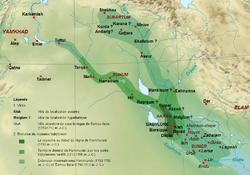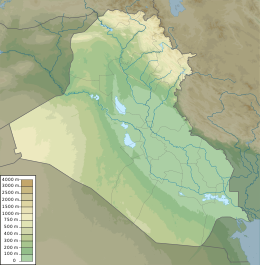First Babylonian Empire
First Babylonian Empire | |||||||||||
|---|---|---|---|---|---|---|---|---|---|---|---|
| c. 1894 BC – 1595 BC | |||||||||||
 | |||||||||||
| Capital | Babylon | ||||||||||
| Common languages | Babylonian language | ||||||||||
| Religion | Babylonian religion | ||||||||||
| Government | Monarchy | ||||||||||
| King | |||||||||||
• c. 1894–1881 BC | Sumu-abum (first) | ||||||||||
• c. 1626–1595 BC | Samsu-Ditana (last) | ||||||||||
| Historical era | Bronze Age | ||||||||||
• Established | c. 1894 BC | ||||||||||
• Sack of Babylon | c. 1595 BC | ||||||||||
• Disestablished | c. 1595 BC | ||||||||||
| |||||||||||
| Today part of | Iraq Syria | ||||||||||
The First Babylonian Empire, or Old Babylonian Empire, is dated to c. 1894 BC – c. 1595 BC, and comes after the end of Sumerian power with the destruction of the Third Dynasty of Ur, and the subsequent Isin-Larsa period. The chronology of the first dynasty of Babylonia is debated as there is a Babylonian King List A[1] and a Babylonian King List B.[2] In this chronology, the regnal years of List A are used due to their wide usage. The reigns in List B are longer, in general.
Before the First Dynasty[]
The more eminent time period preceding the First Dynasty, but taking place after the reign of Sargon the Great (the first ruler of the Akkadian Empire, c. 2334–2284 BC), is referred to as the Third Dynasty of Ur or the Ur III period. This time period took place during the end of the third millennium BC and early second millennium BC. Common behaviors of the kings during this time period, especially Ur-Namma and Shulgi, included reunifying Mesopotamia and developing rules for the kingdom to abide by. Most notably, these rulers of Ur contributed to the development of ziggurats, which were religious monumental stepped towers that would in turn bring religious peoples together. In order to gain and retain power, it was not unfamiliar for Ur princesses to marry the kings of Elam; Elaminites were a commonly known enemy of Mesopotamians.[3] Ur rulers would also, along with arranged marriage, send gifts and letters to other rulers as a peace offering. This is known because of the hefty amount of administrative records dating to the Ur III period, which can now be found on display through collections and museums.[4]
First Dynasty: middle chronology[]
The middle chronology is:
| King | Reigned | Comments | |
|---|---|---|---|
| Sumu-abum or Su-abu | c. 1894–1881 BC | Contemporary of Ilushuma of Assyria | |
| Sumu-la-El | c. 1881–1845 BC | Contemporary of Erishum I of Assyria | |
| Sabium or Sabum | c. 1845–1831 BC | Son of Sumu-la-El | |
| Apil-Sin | c. 1831–1813 BC | Son of Sabium | |
| Sin-muballit | c. 1813–1792 BC | Son of Apil-Sin | |
| Hammurabi (First major ruler)[5] |
c. 1792–1750 BC | Son of Sin-Mubalit and Contemporary of Zimri-Lim of Mari, of Elam and Shamshi-Adad I of Assyria | |
| Samsu-iluna | c. 1750–1712 BC | Son of Hammurabi | |
| Abi-eshuh or Abieshu | c. 1712–1684 BC | Son of Samsu-iluna | |
| Ammi-ditana | c. 1684–1647 BC | Son of Abi-eshuh | |
| Ammi-saduqa or Ammisaduqa | c. 1647–1626 BC | Venus tablet of Ammisaduqa | |
| Samsu-Ditana | c. 1626–1595 BC | Sack of Babylon by the Hittites. |
Origins of the First Dynasty[]
The actual origins of the First Babylonian dynasty are rather hard to pinpoint with great certainty simply because Babylon itself, due to a high water table, yields very few archaeological materials intact. Thus, the evidence that survived throughout the years includes written records such as royal and votive inscriptions, literary texts, and lists of year-names. The minimal amount of evidence in economic and legal documents makes it difficult to illustrate the economic and social history of the First Babylonian Dynasty, but with historical events portrayed in literature and the existence of year-name lists, it is possible to establish a chronology.[6]
The first kings of the dynasty[]

